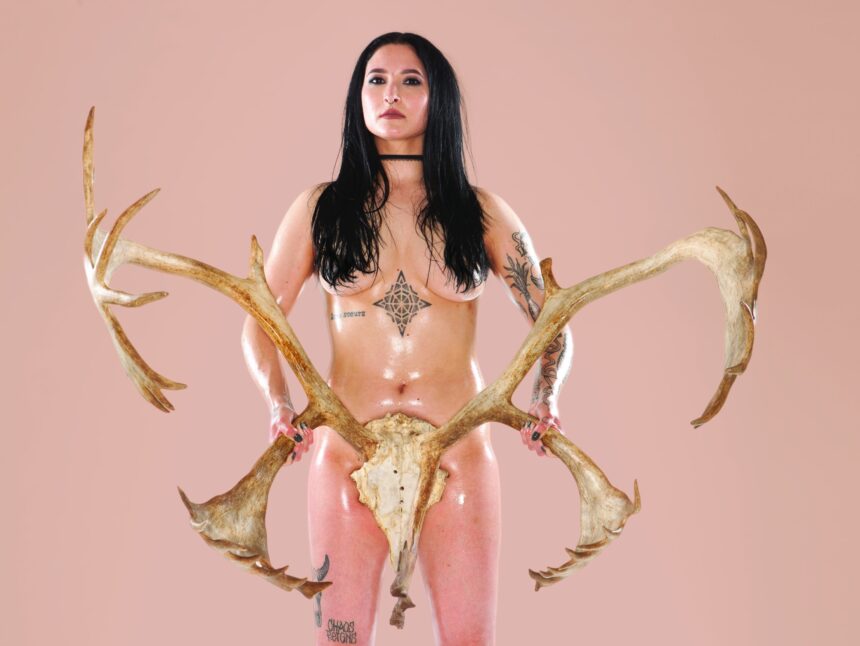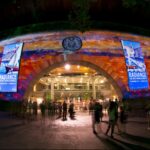On the Indigenous Art ‘Trend’ in Canada: Our ‘Year of Reconciliation’ (And One Year After)
Lindsay Nixon
Haudenosaunee and Anishinabe territories (Montreal, Quebec, Canada)
In 2017, the Canada Council for the Arts implemented a new funding model that included an Indigenous-specific grant program called “Creating, Knowing and Sharing.” This was a direct result of the reconciliation year—a colloquial term reflecting the 150th anniversary of the nation’s founding, but also derived from the Truth and Reconciliation Commission of Canada whose policies address bias claims made by Indigenous peoples against the state. Millions of dollars were spent towards celebrating Indigenous communities (ergo, reconciliation), millions more went to funding the Canada Council. The outcome was profound. I can’t think of another period—outside of 1992, the 350th anniversary of the birth of Montreal and 500 years since Columbus did not discover America—when Indigenous art was this dynamic.
Several survey exhibitions opened across Canada during 2017 and 2018, including Onsite’s Raise the Flag, the Winnipeg Art Gallery’s Insurgence/Resurgence, the Art Gallery of Alberta’s historical Rebecca Belmore retrospective, and the Remai Modern’s controversial Jimmie Durham retrospective. As an Indigenous person and curator it’s no wonder I found myself repeatedly asked by other Canadian cultural workers, colleagues and friends about this trend. What’s exciting is that this Indigenous art ‘trend’ seems deeply rooted in the principles of rematriation: a play on the word repatriation, meaning the return of someone to their own land or country, but herein used in the style of the ReMatriate Indigenous women’s Instagram art collective who reclaim positive representations of Indigenous womanhood. Another project linked with the rematriation process was #CallResponse. It included respected Indigenous artists such as Tarah Hogue, Maria Hupfield, and Tania Willard and toured nationally, centering the creative production and voices of Indigenous North American Women.
Kinship-based Indigenous feminisms have spread throughout both Indigenous and Canadian art discourses and had a noticeable effect on Canadian art criticism over the last two years, influencing panels, Indigenous art criticism, art criticism generally, and arts programing. However, I want to point out that kinship theory comes from communities who have long practiced close ancestral and family ties as a means of social organization. Therefore it is no wonder that early Indigenous net art theorists and artists were Cree, since their practice reads as an extension of their kinship teachings within a post-reality digital world that seeks to define ethical relationships and even global protocols in cyber-space. Archer Pechawis, Cheryl L’Hirondelle, and others have looked to digital worlds to ask, how can we use webs of connection for kin-making?
After October 2017 there was an influx of gender activism in Canada that influenced the art industry on various levels, including the Indigenous art world. These #MeToo inspired happenings coincided with the increase in visibility for Indigenous Canadian art and contributed to the focusing of Indigenous women’s culture as a new ‘art trend.’ It should be noted, before moving into a larger consideration of what rematriation has looked like in Indigenous art curation and programming, that the opposite of toxic masculinity within Indigenous communities is not womanism, but gender diversity, including consciousness-raised masculinity. Pushing out—or more colloquially speaking ‘canceling’ and thereby re-criminalizing—allegedly problematic Indigenous men is not a solution. The alternative is initiating or attempting to engage in some form of community-led healing, something my Cree-Métis-Saulteaux teachings dictate is an important facet of ethical relationality. Ethical community-led healing has been ill- or little-defined amongst Indigenous scholarly communities and art industries and remains the subject of emerging theory and discussion. But there is a difference between canceling men, and acknowledging that Indigenous communities need to de-center masculinity. It feels important to mention the intricacies of #MeToo era gender activism and its influence on Indigenous creative industries because pathways to healing gender violence in our communities are still hotly debated among Indigenous thinkers and makers.
There also seems to be a certain ‘trending’ aspect to Indigenous art within an international context. For the first time a group of Indigenous architects represented Canada at the 2018 Venice Biennale of Architecture, and an Inuit art collective known as Isuma are set to represent Canada at the 2019 Venice Biennale. Of particular interest to me was the Minneapolis Institute of Art’s recent announcement that they were to stage the “first major” survey exhibition of Native women artists. While I do want to give credit where credit is due, and acknowledge the paramount importance of such an exhibit in an American art climate that has historically erased Indigenous artists, the assertion that this is the first major exhibit of Native women artists is a simplification. In the proceeding paragraphs I will outline a selection of women centered exhibitions programmed in Canadian art institutions that I argue constitute some of the first survey exhibitions of Indigenous women artists in North America. I suspect that the Minneapolis Institute of Art’s survey was influenced by the recent moods and discourses stemming from trends of rematriated Indigenous art in Canada, just across the border, including exhibitions that worked to survey histories of Indigenous women’s art alongside current artists (even in cases where said exhibits were not necessarily framed as surveys).
What I found particularly heartening about Indigenous woman-centric curating across Canada from 2017 to 2018 was the readiness to include new ideas, practices, and voices at the forefront of Indigenous art, as if our aunties and kohkoms (grandmothers) were passing us the torch. This was certainly the case with emerging Indigenous curators such as Niki Little, Becca Taylor, Tarah Hogue and Jessie Short, among others. But there was also an emerging recognition of Indigenous queer and trans artists gaining new levels of exposure during the same Reconciliation year.

A clear favorite of the rematriation Indigenous art movement in Canada is sex-positive Métis-Saulteaux artist Dayna Danger, who has recently shown her work in the Biennale d’art contemporain autochtone (BACA), the exhibition Li Salay at the Art Gallery of Alberta, and Resilience, a national billboard exhibition project organized by the Winnipeg-based organization Mentoring Artists for Women’s Art (MAWA). Danger was also featured on the cover of Canadian Art’s 2017 kinship issue. Works from her ongoing series Sisters and Big’Uns, along with her media artwork Bebeschwendaam, focus on the intersections of sexuality, gender, care, love, and Indigenous identity. Given the influx of women-centric Indigenous art in Canada over the last few years, I understand the compulsion to call the aforementioned body of work a trend. However, claiming that rematriated Indigenous art is a trend reveals several art historical problems.
First, to say that Indigenous art is trending in Canada is a false construction for Indigenous peoples, and one that pivots upon a Canadian, and perhaps mostly white, audience. For the Indigenous art community, art is just life. We eat, sleep, and breath NDN art, which connects us to our Indigenous communities in profound ways that we cannot separate from our egos, out there, in the art world.
Second, the 2017-2018 focus on Indigenous Canadian art is not a trend—it is what is owed. Indigenous artists in Canada have long been contending with the phenomenon of the so-called ‘vanishing Indian.’ Art is a space that has been used to perpetuate visual myths that Indigenous peoples are dead or dying out. All of which support a blatantly colonial project to remove Indigenous life and seize and settle Indigenous territory. To call rematriation projects that emerged alongside a rejuvenated focus on Indigenous art from outside our communities a trend is to perpetuate the imaginary Indian at the level of gender. After 400 plus years of colonial imposition, I would say we are due far more than just two years of attention and attempts at returning gender balance within our communities.
Amidst increasing administrative interest in Indigenous art, it’s our responsibility as Indigenous art professionals to recognize that everything we curate, program, and organize is steeped in colonial-institutional politics, and depends upon federal money given to us by the same Liberal Party that announced it will back the Trans Mountain Pipeline running through Indigenous people’s territories, despite unrelenting opposition. While Trump’s policies upset Canadians and our southern neighbors, Prime Minister Trudeau’s government is also (differently) oppressive with troublingly little critique directed his way.
All this begs the question: was the increase of money to support Indigenous cultural initiatives during the reconciliation year just smoke and mirrors meant to distract from the harm Trudeau’s policies will bring to our communities? Was the novel Indigenous presence in Venice meant to present Indigenous peoples as Canada’s treasure, while sweeping resistance under the rug? Though Indigenous art can seem like it exists within a political vacuum at times, a space increasingly bogged down with Canadian administrative cultures and toxic art scene relationalities, we must recognize as Indigenous peoples that we are complicit in the politics we ultimately condone and participate in. In short, Indigenous art happenings that followed the reconciliation year in Canada have left me with questions, or critiques perhaps, for both Indigenous and non-Indigenous Canadian arts administrators. Why are Indigenous artists, especially local communities, not being better consulted in Indigenous art programming in Canada? How are Indigenous artists being held accountable when they lend support to institutions and what are their responsibilities when they do? And, finally, what are Canada’s arts institutions doing to ensure that they are continuing to create space for Indigenous art and artists?
There’s an NDN art oral history about James Luna. As retold by Paul Chaat Smith, in 1992 James Luna was riding high off of the success of Artifact Piece (first performed in 1987 at the San Diego Museum of Man). America was celebrating the 500th anniversary since Columbus did not discover the Americas and Luna was critical of an art industry that suddenly craved his work. Hesitant to participate in voyeuristic framings of his practice, Luna responded to galleries and museums interested in his work by asking: “You’re calling me now, but will you call me in ’93?” To borrow from James Luna—may he rest in power—I ask, will Canadian art galleries still remember Indigenous women, gender variant, and trans artists after the reconciliation year?
Lindsay Nixon is a Cree-Métis-Saulteaux curator, award-nominated editor, award-nominated writer and McGill Art History Ph.D. student. They currently hold the position of Editor-at-Large for Canadian Art. Nixon previously edited mâmawi-âcimowak, an independent art, art criticism and literature journal, and their writing has appeared in Malahat Review, Room, GUTS, Mice, esse, Inuit Art Quarterly, Teen Vogue and other publications. Their memoir, nîtisânak, was released in September 2018 through Metonymy Press. Born and raised in the prairies, Lindsay currently lives in Tio’tia:ke/Mooniyaang—unceded Haudenosaunee and Anishinabe territories (Montreal, QC).







